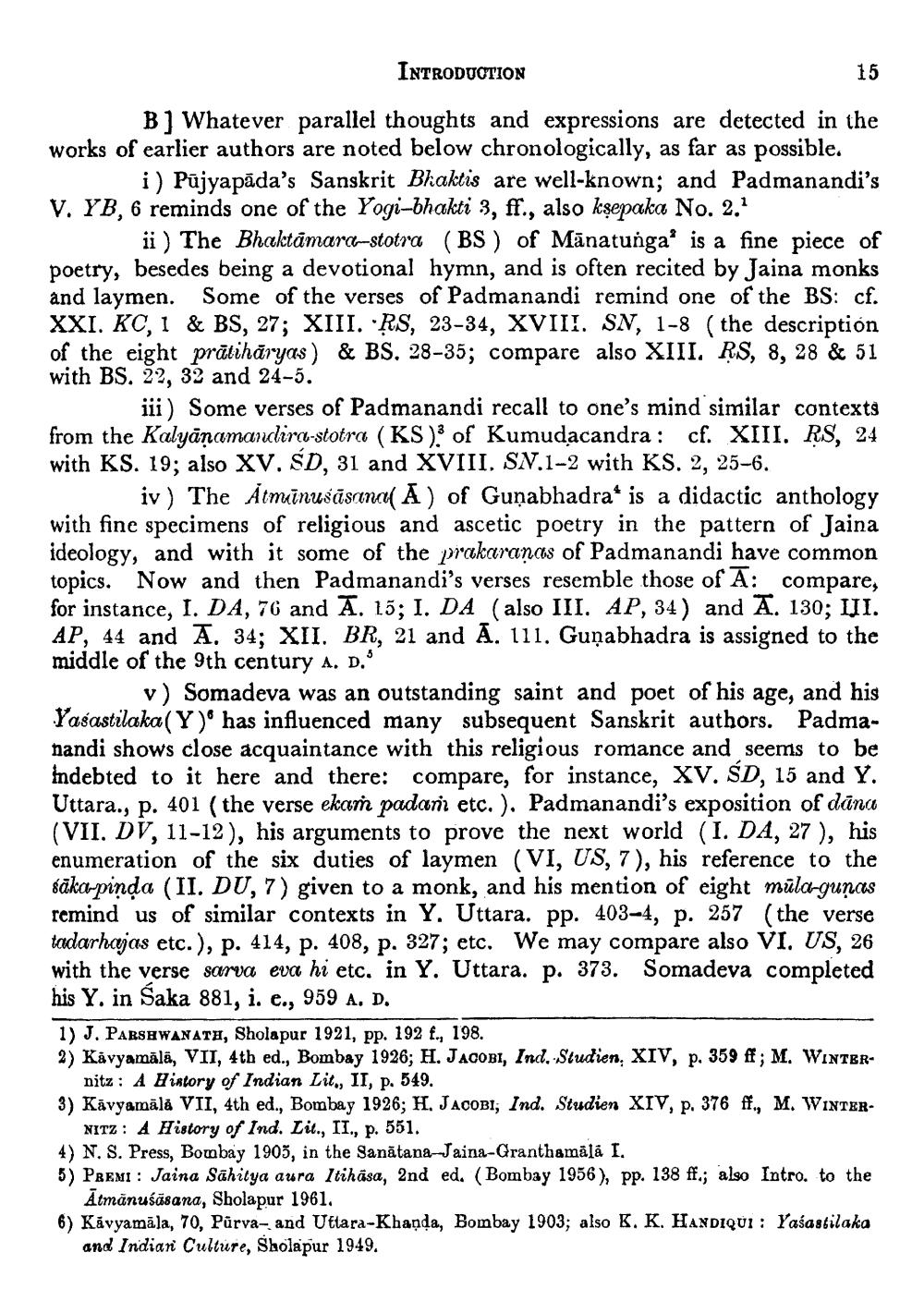________________
INTRODUCTION
15
B] Whatever parallel thoughts and expressions are detected in the works of earlier authors are noted below chronologically, as far as possible.
i) Pūjyapāda's Sanskrit Bhaktis are well-known; and Padmanandi's V. YB, 6 reminds one of the Yogi-bhakti 3, ff., also ksepaka No. 2."
ii) The Bhaktāmarca-stotra (BS) of Mānatunga' is a fine piece of poetry, besedes being a devotional hymn, and is often recited by Jaina monks and laymen. Some of the verses of Padmanandi remind one of the BS: cf. XXI. KC, 1 & BS, 27; XIII. RS, 23-34, XVIII. SN, 1-8 (the description of the eight prātihāryas) & BS. 28-35; compare also XIII, RS, 8, 28 & 51 with BS. 22, 32 and 24-5.
iii) Some verses of Padmanandi recall to one's mind similar contexts from the Kalyāṇamandira-stotra (KS) of Kumudacandra: cf. XIII. RS, 24 with KS. 19; also XV. ŚD, 31 and XVIII. SN.1-2 with KS. 2, 25-6.
iv) The Atmiinusāsanal A) of Guņabhadra* is a didactic anthology with fine specimens of religious and ascetic poetry in the pattern of Jaina ideology, and with it some of the prakaranas of Padmanandi have common topics. Now and then Padmanandi's verses resemble those of A: compare, for instance, I. DA, 76 and A. 15; I. DA (also III. AP, 34) and A. 130; III. AP, 44 and A. 34; XII. BR, 21 and A. 111. Guņabhadra is assigned to the middle of the 9th century A. D.
v) Somadeva was an outstanding saint and poet of his age, and his Yasastilaka(Y) has influenced many subsequent Sanskrit authors. Padmanandi shows close acquaintance with this religious romance and seems to be Indebted to it here and there: compare, for instance, XV. ŚD, 15 and Y. Uttara., p. 401 (the verse ekaṁ padan etc. ). Padmanandi's exposition of dāna (VII. DV, 11-12), his arguments to prove the next world (I. DA, 27 ), his enumeration of the six duties of laymen (VI, US, 7), his reference to the sāka-pinda (II. DU, 7) given to a monk, and his mention of eight müla-guņas remind us of similar contexts in Y. Uttara. pp. 403-4, p. 257 (the verse tadarhajas etc.), p. 414, p. 408, p. 327; etc. We may compare also VI. US, 26 with the verse sarva eva hi etc. in Y. Uttara. p. 373. Somadeva completed his Y. in Saka 881, i. e., 959 A. D. 1) J. PARSHWANATH, Sholapur 1921, pp. 192 £., 198. 2) Kávyamālā, VII, 4th ed., Bombay 1926; H. JACOBI, Ind. Studien, XIV, p. 359 ff; M. WINTER
nitz: A History of Indian Lit., II, p. 549. 3) Kāvyamälá VII, 4th ed., Bombay 1926; H. JACOBI; Ind. Studien XIV, p. 376 ff., M. WINTER
NITZ: A History of Ind. Lit., II., p. 551. 4) N. S. Press, Bombay 1903, in the Sanātana-Jaina-Granthamälá I. 5) Peemi: Jaina Sahitya aura Itihasa, 2nd ed. (Bombay 1956), pp. 138 ff; also Intro. to the
Ātmānuśāsana, Sholapur 1961, 6) Kávyamāla, 70, Purva- and Uttara-Khanda, Bombay 1903; also 6. K. HANDIQUI : Yasastilaka
and Indian Culture, Sholapur 1949.




